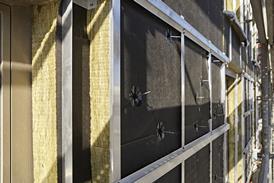John Weir, Technical Director of the Glass & Glazing Federation, retires this month. He recently spoke to Dominic Bentham about his 28 years’ service to the industry and his involvement in British, European and ISO Standards, and Building Regulations
I gather you were employed jointly by the four respective trade associations for flat glass, insulated glass, fire resistant glass and glass bending, shortly before they amalgamated to form the GGF.
The Glass & Glazing Federation (GGF) was launched in February 1977. I was already the Technical Secretary to various groups and then got the job as Standards Secretary. I went straight away into BSI committees and from there the beginnings of European Standards harmonisation. I didn’t have prior experience in glass but I had a technical background so I knew what was going on. I studied Physics at university.
The great thing about the formation of the Federation was that all these people sat round a meeting table. When you have to join together to lobby the government (safety glazing was the thing when I first arrived), that does bring things together.
As far as I am concerned, the big thing the Federation did over the years was foster the development of technical standards. As with many industries, computerisation has made a tremendous difference to the way we work, and has enabled us to get the input of lots of smaller companies.
Were you surprised at the rapid rise of the PVC-U window companies?
It simply was that they were much more efficient and saw their opportunity. The traditional glass industry was asleep at the time.
How has the GGF developed as an information resource?
We cover a vast range of subjects: Everything from the manufacture of glass to double glazed units, mirrors, to the supply of framing and fixing materials, the glass merchant, the glazier and the window installer. We have tried to pull all these things together and build up a base of information, and we have had to work quickly.
We can be asked questions about any of these areas. The answers may not be at our fingertips but we can find out. While there are some extremely knowledgeable people in the industry, there are always some areas outside their experience.
There is a lot still to be done in relaying the information back out the membership. There is also tremendous scope for educating the specifiers. Architects don’t just have glass, windows or curtain walling to deal with – their brief is much bigger than ours.
On the consumer side it could be guidance about where to get a particular product, or which is best, and if course if someone’s got a complaint about a member, we will take that up and conciliate. We don’t have many cases these days.
You’ve worked to establish some key British Standards, and these are now giving way to European ones.
Harmonisation of European Standards is the key thing that has happened over the last 20 years and that has been the major thing that I have been involved in.
Originally, everyone was talking about harmonising European standards by 1992, but we didn’t come anywhere near meeting that target because it was a much more complex operation. It’s taken a generation of people to get it up and running. I think the politicians created some target dates which were impossible to meet. It’s now coming to fruition at last.
To the outsider, this seems to be a painfully slow process.
1279 is a classic case. I think we first met in 1988. For the first two or three years several meetings took place but they all consisted of member states fighting to get their national standard adopted as the European standard. There was tremendous pressure from the Scandinavians, who reckoned they’d already got the best of all possible technical standards and quality control systems already operating. ‘Here it is chaps, just take this and call it CEN.’
The Germans reacted very strongly against that and put their own pressure on, and so did we. Everyone’s standards were radically different from each other. Then there was the problem of translation, and luckily they agreed on English.
It was clear that no progress was being made, so we had to start from scratch. As soon as you do that you have to do ‘round robin’ testing in laboratories in each of the member countries, get units manufactured in each of the countries, pass them around and get them tested to the new specification. Tests could take nine months in those days, because there was guesswork initially to set humidity and cycle times.
And then people would query the results from different laboratories – technical questions, but nevertheless the politics is still there.
Once you’ve got the basic test method agreed you’ve then got to decide what sort of quality control procedures to introduce and the administrative details – whether independent testing is required.
Then there were different designs of sealed unit to test – Swiggle units, Glaverbel’s Thermopane welded metal and glass units, and so on.
It appears that sealed unit manufacturers have been given ample time to achieve compliance.
They’ve had a chance but a lot of them haven’t taken it. For a long time it didn’t look as though the tests would be this hard. There are a lot of unit manufacturers and a limited number of test facilities – BSI and Chiltern Dynamics/TRADA here, Rosenheim and other places overseas but you’ll be bottom of the pile. If you fail it’s a long wait to test again. A lot of companies must be counting the days until this becomes mandatory.
Safety glazing standards must be one of the major achievements of your generation.
I would say so. When I started, ‘What was safety glazing and where did you have to use it?’ was being argued. That became Part N of the Building Regulations and BS6262.
There are still things to talk about but it’s been a tremendous step forward. When I came along people were still arguing that 3mm annealed glass was fine for patio doors and there were cases of people walking into them and cutting badly cut.
How far can standards go in future?
Within 20 years there will be a whole raft of international standards for all aspects of glass and windows that will cover the globe.
It’s amazing who turns up to the ISO standards meetings. The Americans don’t want to miss out on an opportunity to lead the way. The Australians have always been interested because they feel out on a limb geographically and don’t liase very closely with the Americans.
The Japanese got very actively involved and we now have the Chinese participating seriously. They do a lot of testing and come back with proposals for incorporation into the draft of ISO standards. And we’ll see more and more countries attending, and delivering papers at conferences such as Glass Processing Days.
E-mail has changed this process dramatically but everything has to be done professionally.
Do any amusing moments come to mind?
Certain sectors of the GGF are more international and in earlier times the Laminators Group comprised Monsanto, DuPont, and Dynamit Nobel, all PVB suppliers at that time. Most groups meet together to discuss technical matters, but Monsanto were only allowed to meet with us individually, and at Glasstec would arrange an invitation-only do at their hotel.
One year Monsanto organised their evening on the same night as DuPont and the two parties collided in the Aldstadt in Dusseldorf. Here were the senior technical people of the European divisions of Monsanto and Dupont, all slapping each other on the back. We’d all had more than our fair share and it ended up as a sing song. Up until then I wasn’t sure how they’d know each other if they actually met.
John Weir
John Weir is looking forward to gardening and walking his new arrival, a terrier cross. He lives in a 1640s property in East Sussex with his wife, Rosemary. They met through the GGF and married in 1981. Gilles Wilson takes over as Director of Technical Affairs at the GGF.
Source
Glass Age




















No comments yet